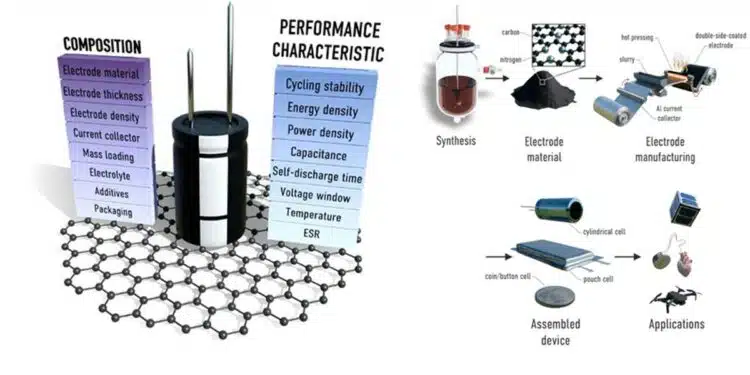Ivan Dědek et al from CATRIN, Palacky University Olomouc, Czech Republic published an article on “High-Performance Carbon-Based Supercapacitors” Published by IOP Publishing Ltd.
Introduction
This article explores the rapidly evolving landscape of carbon-based supercapacitors (SCs), focusing on electric double-layer capacitors (EDLCs).
These devices offer fast charging, long cycle life, and high power density, making them suitable for a wide range of applications—from consumer electronics to aerospace. The discussion centers on advances in activated carbon (AC), graphene, and their derivatives, while emphasizing the challenges of transitioning high-performance materials from laboratory research to scalable commercial devices. Sustainability and systems-level optimization are recurring themes throughout the article.
Key Points
- Carbon-based SCs are poised to bridge the gap between traditional capacitors and lithium-ion batteries.
- Activated carbon and graphene are key electrode materials, but real-world performance lags behind lab results.
- Device architecture, electrode thickness, and testing methods impact performance outcomes.
- Emerging materials like N-doped graphene and graphdiyne offer potential but face scalability issues.
- Electrolyte selection and thermal operating range are critical for optimizing energy and power density.
- Environmental and safety standards must be met for industrial adoption.
Extended Summary
The article begins by highlighting the role of supercapacitors in meeting the UN’s energy goals through improved electrochemical energy storage. EDLCs offer advantages such as fast charge/discharge cycles, long life, and reduced safety risks. Carbon-based materials, particularly AC and graphene, dominate current SC technology due to their conductivity and abundance.
Real-world SC performance, however, often falls short of lab benchmarks. The discrepancy stems from differences in electrode thickness, device design, and performance reporting standards. Thin lab-scale electrodes perform better due to full ion accessibility, while practical devices with thicker electrodes exhibit lower capacitance. Furthermore, volumetric energy densities tend to be diluted due to excessive porosity and low packing density of nanomaterials like graphene.
The paper explores various carbon materials used for electrodes. Activated carbon, derived from biomass or plastic waste, is porous and cost-effective but hydrophobic. Surface functionalization or N-doping improves ion accessibility and adds pseudocapacitive effects. Graphene, although promising, suffers from restacking issues, which reduce surface area. Curved or defective graphene mitigates these limitations and has already shown scalability in commercial devices. Graphdiyne, a newer carbon allotrope, has great potential but faces production and consistency challenges.
Device form factor influences SC performance. Wound-cell configurations offer manufacturing scalability, while pouch-type cells are ideal for space-constrained designs. Each architecture comes with trade-offs in energy density, mechanical stability, and cost. The market demands SCs with higher energy densities, thermal stability, and compatibility with surface-mount technology, especially for high-temperature reflow soldering.
Electrolytes are crucial for determining performance. Aqueous electrolytes are voltage-limited; organic electrolytes and ionic liquids offer wider windows and better energy density. However, ionic liquids are expensive and often viscous, limiting ion transport. Strategies such as blending ILs with low-viscosity solvents or developing eutectic mixtures are being explored to extend operational temperature ranges.
Manufacturing processes also play a pivotal role. NMP is commonly used as a solvent but poses environmental risks, driving research into safer alternatives like water-based or green organic solvents. Nonetheless, performance trade-offs remain a challenge.
The paper concludes with a call for holistic optimization. Improvements should target not only active materials but also electrolytes, device architecture, and regulatory alignment. Micro-supercapacitors and hybrid devices combining SCs and batteries represent emerging directions. Continued interdisciplinary research is needed to close the performance gap and make carbon-based SCs viable for widespread adoption.
Conclusion
Carbon-based supercapacitors hold significant promise for energy storage solutions that require rapid charge-discharge cycles, safety, and sustainability. While advanced materials such as curved graphene and graphdiyne offer excellent electrochemical properties, industrial implementation is hindered by scalability, cost, and integration challenges. Addressing these requires a systems-level approach, from material innovation to manufacturing processes and regulatory compliance. The future of SCs lies in their adaptability across diverse applications, and with ongoing research, they are well-positioned to become indispensable components of next-generation energy systems.
Read the complete article here:
High-Performance Carbon-Based Supercapacitors, Ivan Dědek, Veronika Šedajová, Vojtěch Kupka, Tomáš Zedníček, Luca Primavesi, Doron Aurbach, Malachi Noked and Michal Otyepka, Accepted Manuscript. Published by IOP Publishing Ltd, DOI 10.1088/2053-1583/adf653, https://iopscience.iop.org/article/10.1088/2053-1583/adf653































